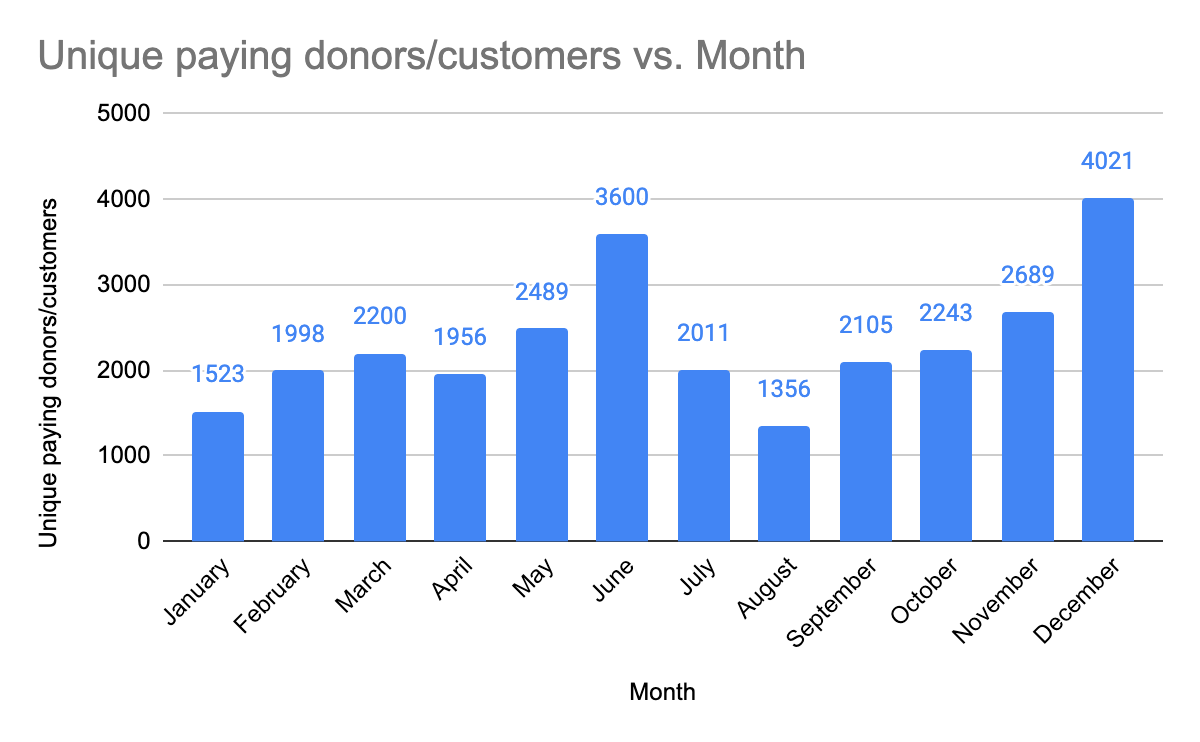FinDock pricing for nonprofits explained
This article is only for contracts signed prior to 1 May 2022.
FinDock pricing is based on the average number of active contacts - that is, the number of unique paying contacts and accounts - per calendar month.
What is an active contact?
An Active FinDock Contact is a Salesforce contact or account record for which one or more FinDock payment records are created during a calendar month, regardless of whether a customer pays once or multiple times in a calendar month.
| # | John - $10 on April 4th | Mary - 15 on April 2nd | Acme Co - 25 on April 20th - $5 on May 3rd |
|---|---|---|---|
| Counts Towards Active Contact April | 1 | 1 | 1 |
| Counts Towards Active Contact Mary | 0 | 0 | 1 |
How do we determine the number of active contacts per month?

When we add the counts of all the individual months together, the total is: 28191. Divided by 12 for the average per month: 2349 => the basis for your FinDock price calculation.
How averaging per month is advantageous to you!
Averaging the number of active contacts makes for a slightly more complex calculation. However, it provides you as a customer with a tremendous advantage. Namely, the impact of months with higher numbers of payments is diminished by months with lower numbers.
In the example above, even though the number of active contacts in June (3600) and December (4021) are significantly higher, the months with lower numbers such as January (1523) and August (1356) balance out those high numbers.
Technical details
The following describes how the number of Active Contacts is calculated for a given month. This calculation forms the basis for the FinDock pricing and invoicing.
Terms and definitions:
- Payment: A payment recorded in the FinDock data model in the
cpm__Payment__c object. - Initial Contract Start Date: The start date of the contract between FinDock and the customer.
- Measured Payment: a payment record with a collection date (
cpm__Collection_Date__c) on or after the Initial Contract Start Date. - Payer Id: the contact ID (
cpm__Contact__c) or Account ID (cpm__Account__c) on the payment record. If both values are available, Contact takes priority. If both values are empty, the payment is treated as belonging to a unique Payer. - Payment Creation Month: the month & year in which a payment record was created, based on the record creation date (CreatedDate).
Example: If the payment record was created on 15/3/2019, the Payment Creation Month is March 2019. - Payment Collection Month: the month & year in which the payment record was collected, based on Payment Collection Date (
cpm__Collection_Date__c).
Example: If the payment was collected on 23/8/2020, the Payment Collection Month is August 2020. - Normal Payment: a payment for which the Payment Creation Month is at most one month later than the collection month.
Example: If the Payment Collection Month is August 2020 and the Payment Creation Month is either August or September 2020, the payment is considered a Normal Payment. - Late Created Payment: a payment for which the creation month is more than one month later than the Payment Collection Month.
Example: If the Payment Collection Month is August 2020 and the Payment Creation Month is October 2020 or later, the payment is considered a Late Created Payment.
Active Contacts for month M
{Number of unique Payer Ids in all Normal Payments collected during month M}
+
{Number of unique “Payer Id + Payment Collection Month” combinations in all Late Created Payments created in month M.}
Example 1
Jenny makes two payments in March 2020. Organization “Acme Co” makes one payment in March 2020. The related Payment record only has an Account Id, not a Contact Id.
| # | Contract Start Date | Who | Collection Date | Created Date | Counts for which month |
|---|---|---|---|---|---|
| 1 | 1/2/2019 | John | 13/3/2020 | 13/3/2020 | 3/2020 |
| 2 | 1/2/2019 | John | 21/3/2020 | 21/3/2020 | 3/2020 |
| 3 | 1/2/2019 | Acme Co | 22/3/2020 | 22/3/2020 | 3/2020 |
Active contacts for month 3/2020: 2 (John and Acme Co).
Example 2
A CAMT file is uploaded beginning April 2020. This includes some payments for March 2020.
| # | Contract Start Date | Who | Collection Date | Created Date | Counts for which month |
|---|---|---|---|---|---|
| 1 | 1/2/2019 | John | 28/3/2020 | 2/4/2020 | 3/2020 |
| 2 | 1/2/2019 | John | 27/3/2020 | 2/4/2020 | 3/2020 |
| 3 | 1/2/2019 | Mary | 26/3/2020 | 2/4/2020 | 3/2020 |
| 4 | 1/2/2019 | John | 1/4/2020 | 2/4/2020 | 4/2020 |
Active contacts for month 3/2020: 2 (John and Mary).
Active contacts for month 4/2020: 1 (John).
Example 3
A data migration is performed in May 2020.
| # | Contract Start Date | Who | Collection Date | Created Date | Counts for which month |
|---|---|---|---|---|---|
| 1 | 1/2/2019 | John | 4/3/2016 | 14/5/2020 | Not counted. |
| 2 | 1/2/2019 | John | 27/4/2019 | 14/5/2020 | 5/2020 (late created) |
| 3 | 1/2/2019 | John | 28/4/2019 | 14/5/2020 | 5/2020 (late created) |
| 4 | 1/2/2019 | John | 3/5/2019 | 14/5/2020 | 5/2020 (late created) |
| 5 | 1/2/2019 | John | 16/4/2020 | 14/5/2020 | 4/2020 |
Active contacts for month 5/2020: 2 (“John - 4/2019” and “John - 5/2019”).
Active contacts for month 4/2020: 1 (John).

